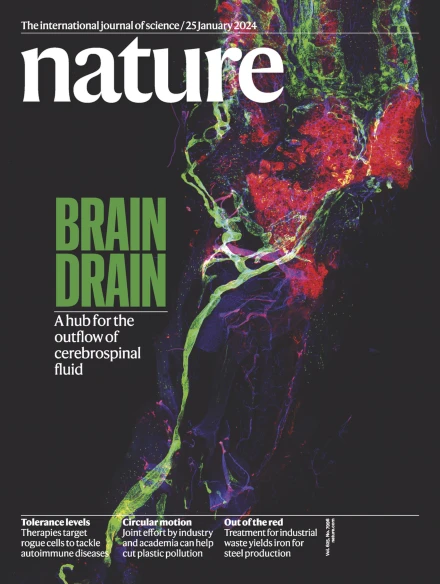Melt focusing along lithosphere–asthenosphere boundary below Axial volcano
IF 48.5
1区 综合性期刊
Q1 MULTIDISCIPLINARY SCIENCES
引用次数: 0
Abstract
Beneath oceanic spreading centres, the lithosphere–asthenosphere boundary (LAB) acts as a permeability barrier that focuses the delivery of melt from deep within the mantle towards the spreading axis1. At intermediate-spreading to fast-spreading ridge crests, the multichannel seismic reflection technique has imaged a nearly flat, 1–2-km-wide axial magma lens (AML)2 that defines the uppermost section of the LAB3, but the nature of the LAB deeper into the crust has been more elusive, with some clues gained from tomographic images, providing only a diffuse view of a wider halo of lower-velocity material seated just beneath the AML4. Here we present 3D seismic reflection images of the LAB extending deep (5–6 km) into the crust beneath Axial volcano, located at the intersection of the Juan de Fuca Ridge and the Cobb–Eickelberg hotspot. The 3D shape of the LAB, which is coincident with a thermally controlled magma assimilation front, focuses hotspot-related and mid-ocean-spreading-centre-related magmatism towards the centre of the volcano, controlling both eruption and hydrothermal processes and the chemical composition of erupted lavas5. In this context, the LAB can be viewed as the upper surface of a ‘magma domain’, a volume within which melt bodies reside (replacing the concept of a single ‘magma reservoir’)6. Our discovery of a funnel-shaped, crustal LAB suggests that thermally controlled magma assimilation could be occurring along this surface at other volcanic systems, such as Iceland. 3D seismic reflection images of the lithosphere–asthenosphere boundary beneath Axial volcano show a magma assimilation front that focuses magmatism towards the centre of the volcano, controlling both eruption and hydrothermal processes.


熔体沿轴向火山下方岩石圈-软流圈边界集中
在海洋扩张中心之下,岩石圈-软流圈边界(LAB)充当了一个渗透屏障,将地幔深处的熔融物输送到扩张轴。在中蔓延到快速蔓延的脊顶,多通道地震反射技术已经成像了一个几乎平坦的,1 - 2公里宽的轴向岩浆透镜(AML)2,它定义了LAB3的最上面部分,但是LAB3更深的本质更加难以理解,从层析成像图像中获得的一些线索,只能提供一个位于AML4下方的更宽的低速物质晕的漫射视图。在这里,我们展示了位于Juan de Fuca Ridge和Cobb-Eickelberg热点交汇处的轴向火山下延伸至地壳深处(5-6公里)的LAB的三维地震反射图像。LAB的三维形状与热控岩浆同化前沿相一致,将热点相关和中大洋扩张中心相关的岩浆活动集中到火山中心,控制了喷发和热液过程以及喷发熔岩的化学成分5。在这种情况下,岩浆带可以被看作是“岩浆域”的上表面,这是一个熔体驻留的区域(取代了单一“岩浆库”的概念)。我们发现了一个漏斗状的地壳LAB,这表明在其他火山系统(如冰岛),热控制的岩浆同化可能沿着这个表面发生。
本文章由计算机程序翻译,如有差异,请以英文原文为准。
求助全文
约1分钟内获得全文
求助全文
来源期刊

Nature
综合性期刊-综合性期刊
CiteScore
90.00
自引率
1.20%
发文量
3652
审稿时长
3 months
期刊介绍:
Nature is a prestigious international journal that publishes peer-reviewed research in various scientific and technological fields. The selection of articles is based on criteria such as originality, importance, interdisciplinary relevance, timeliness, accessibility, elegance, and surprising conclusions. In addition to showcasing significant scientific advances, Nature delivers rapid, authoritative, insightful news, and interpretation of current and upcoming trends impacting science, scientists, and the broader public. The journal serves a dual purpose: firstly, to promptly share noteworthy scientific advances and foster discussions among scientists, and secondly, to ensure the swift dissemination of scientific results globally, emphasizing their significance for knowledge, culture, and daily life.
 求助内容:
求助内容: 应助结果提醒方式:
应助结果提醒方式:


